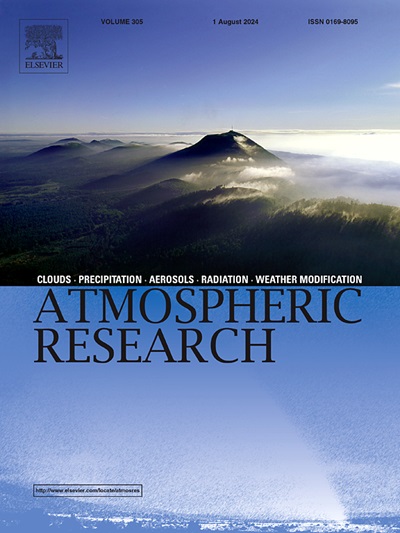地中海伊比利亚半岛中部雾水收集的年际波动和有影响的大尺度对流层环流型
IF 4.5
2区 地球科学
Q1 METEOROLOGY & ATMOSPHERIC SCIENCES
引用次数: 0
摘要
本研究考察了地中海伊比利亚半岛中部(MIP)月累积雾水量(CFW)的平均年周期,强调了气象条件、地形和地理位置之间的相互作用。雾-水收集的季节不对称性明显,夏季雾收集频率较高,但水量较低。相比之下,非夏季的雾事件频率较低,但强度较高。本文章由计算机程序翻译,如有差异,请以英文原文为准。
Year-to-year fluctuations in fog-water collection in central Mediterranean Iberian Peninsula and the influential large-scale tropospheric circulation patterns
This study examines the mean annual cycles of monthly cumulated fog-water amounts (CFW) in the central Mediterranean Iberian Peninsula (MIP), highlighting the interplay between meteorological conditions, topography, and geographic location. Seasonal asymmetry in fog-water collection is evident, with summer exhibiting higher fog collection frequency but lower water volumes. In contrast, non-summer seasons feature lower frequency but higher intensity fog events.
Tropospheric circulation anomalies at mid- and low-tropospheric levels reveal that fog-water collection is influenced by moisture transport from the Mediterranean, particularly during high fog-collection months. Positive specific humidity anomalies near coastal areas, driven by southeasterly wind anomalies, are crucial for frequent fog formation, while broader, less concentrated anomalies characterize higher-intensity fog events. These findings align with prior research emphasizing the role of cyclonic conditions and maritime moisture advection in enhancing fog-water collection yields.
Additionally, seasonal variations in tropospheric circulation anomalies are linked to large-scale teleconnection patterns such as the North Atlantic Oscillation (NAO), Arctic Oscillation (AO), and Eastern Atlantic-Western Russia (EAWR) patterns. These modulate moisture advection, precipitation anomalies, and low-level winds that drive fog formation and collection. In summer, subtropical high-pressure weakening contributes to increased fog-water cumulates, while winter anomalies highlight the impact of quasi-stationary cyclonic circulations and autumn anomalies, positive NAO/AO phases.
These results underscore the climatic importance of fog-water collection for water resource management in drought-prone regions and provide a foundation for future climate monitoring and prediction under anthropogenic radiative forcing. The study's insights have practical implications for enhancing water availability through fog collection in Mediterranean ecosystems.
求助全文
通过发布文献求助,成功后即可免费获取论文全文。
去求助
来源期刊

Atmospheric Research
地学-气象与大气科学
CiteScore
9.40
自引率
10.90%
发文量
460
审稿时长
47 days
期刊介绍:
The journal publishes scientific papers (research papers, review articles, letters and notes) dealing with the part of the atmosphere where meteorological events occur. Attention is given to all processes extending from the earth surface to the tropopause, but special emphasis continues to be devoted to the physics of clouds, mesoscale meteorology and air pollution, i.e. atmospheric aerosols; microphysical processes; cloud dynamics and thermodynamics; numerical simulation, climatology, climate change and weather modification.
 求助内容:
求助内容: 应助结果提醒方式:
应助结果提醒方式:


